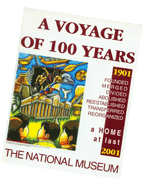ANTHROPOLOGY DIVISION

Function
Conducts scientific researches on the people of the Philippines, including economic and ecological anthropology, ethnography/ethnology, linguistics, and paleoanthropology that support the research, development and conservation in physical and natural sciences.
Historical Notes
One of the oldest foundations of the National Museum, the Anthropology Division traces its beginnings back to 1901. The Division consisted of three sections: Archaeology, Ethnography, and Physical Anthropology.
The Anthropology Division had devoted practically half of its life in archaeological and ethnological studies and researches, focusing on the earliest man on Philippine grounds and pre-historic culture. Tragically, however, most of the records turned into ashes during World War II, leaving the Division with nothing but vivid memories and recollections of past efforts.
In 1962, Dr. Robert B. Fox, Chief Anthropologist of the National Museum, discovered the fossilized Pleistocene skull of the oldest man in the Philippines inside the Tabon Caves of Quezon, Palawan. The discovery drew international attention and recognition, thus placing Philippine Anthropology in the limelight. As a result, the National Museum received grants from the National Geographic Society and the National Science Development Board for the production and publication of "Tabon Caves: Archaeological Exhibitions and Explorations in Palawan Island, Philippines" in 1968.
Other major archaeological undertakings in the 1960s were: the Sta. Ana Excavation that revealed Filipino habitation and burial sites dating more than 400 years before the arrival of Spaniards in Manila; Laguna de Bay Excavation Project that established a chronological link between the Period of Contact and Trade with Asian countries and the early Neolithic Age; Panay Archaeological Project which confirmed the Museum's research on "Porcelain Year"; the Tambac Cave Mummies; the Ati-Atihan Festival; Dr. Felipe Landa Jocano's study on the social structure and cultural changes in rural communities; and the research and photographic documentation of the Lenten rituals performed by the local residents and pilgrims of Paombong, Bulacan.
Despite shortage of funds, the Anthropology Division managed to open various exhibitions, foremost of which were "The Muslim Filipino Art Exhibition", The "Kabihasnan" Series, a twopart presentation consisting of "Sa Daigdig ng Maranao" on one part and "Sa Daigdig ng Ifugao"; and the "DuhIgan" or transfer rites of Ifugaos.
While the National Museum was still mourning the death of Prof. H. Otley Beyer on December 31, 1966, archaeological projects were pursued in Cagayan Valley. Important studies were: "The Ancient Man and Pleistocene Fauna in Cagayan Valley", "Glass in Archaeology", "Bead Typology", and "Flake Tool Analysis". Cognizant of the need for a holistic and integrated approach to the study and application of traditional art designs and crafts, the Ethnology Section of the Anthropology Division became involved in the OKIR Project as well as in the Ethnographic Arts Research and Development Projects. Even Filipino-madejeweliy and ornaments used by prehistoric man and various ethnolinguistic groups did not skip the interest of the Ethnology Section. Specimens of this nature were presented in a permanent exhibition entitled " Hiyas ng Kabihasnan"
The massive studies and researches in Philippine Anthropology had earned fame and public respect for Jesus Peralta, Eric S. Casino, Alfredo Evangelista, Leonardo Concepcion, and Avelino M. Legaspi.
An all-time ethnographic masterpiece, the Tau't Batu Ethnography, was initiated by President Marcos in May 1978. It featured the photographic documentation of the Tau't Batu people in Singnapan, Ransang, Quezon, Palawan, and their related subsistence activities. A reservation of 14,000 hectares was established in this area for the project.
While the Division was preocuppied with anthropological researches, exhibits and technical assistance in museology and museography in addition to the production of technical papers and other publications, a catastrophe in the last quarter of 1995 halted these efforts. Super typhoon "Rosing" destroyed a portion of the roof of the National Museum Building, leaving the Ethnology Section flooded. Heavily damaged were numerous ethnographic specimens, research manuscripts, photographic documents and other records.
Towards the end of 1990s, the Division undertook projects concerning ethnic mapping: Revalidation and Publication of Ethnographic Catalogues; the Whale-Shark Hunting Culture among the Pamilacan Islanders in Bohol; the Systematic Documentation, Inventory, and Mapping of the Benguet Mummies in Kabayan, Benguet.
The return of Apo Annu to Buguias, Benguet in May of 1999 where it was finally laid to rest in a rock shelter in Nabalicong was another monumental event for the Division. Several rituals were performed to honor Apo Annu's return.
During the last quarter of the year 2000, Philippine ethnographic specimens from the ethnographic specimens from the ethnographic collections of General Bandholtz and Mr. and Mrs. Cook from Chicago, USA were turned over and shipped to the National Museum. These were documented and later temporarily exhibited at the 2nd Floor of the National Museum entitled "Crafts and Weapon: A Homecoming from St. Louis Exposition 1904." An additional 52-piece collection of assorted ethnographic materials averaging from 80 to 100 years old were later donated by the Charleston Museum of South Carolina as arranged by then Ambassador Ernesto Maceda through the Philippine Embassy in Washington, D.C.
The Anthropology Division remains a strong bastion of Philippine cultural and ethnographic studies.
Turning Points
Through time, as efforts in the anthropological discipline became more intensive, some organizational reforms were deemed necessary. First, a Chemical and Physical Laboratory was set up in 1977, where soil samples from the excavation projects in Cagayan were initially analyzed. Known today as Chemistry and Conservation Laboratory, this unit undertakes chemical analyses of specimens and artifacts gathered by the researchers of the National Museum.
Following this move, a Zooarcheology Section was created in 1987, tasked to undertake researches concerning osteology, paleontology and zooarchaeology of important animal species that could help in the reconstruction of the prehistory of the country. Another structural reorganization took place in 1988 when the Archaeology Section was separated from the Anthropology Division, leaving it with only two sections:
Ehnology and the Laboratory.
The discovery of the "balanghai" boats used in pre-Spanish times in Butuan City in 1977 signalled a new wave of scientific interest in underwater archaeology. The Marinduque UnderwaterArchaeology Project, Puerto Galera Underwater Archaeological Project, and the Lubang Island Underwater Archaeology Project were all undertaken in the 1980s.
The Division considered the ancient agricultural calendars of Besao, Bontoc, Mountain Province as significant evidences of ancient Filipino applied mathematical science. It also treated the Petroglyphs of Angono, Rizal, ancient rock drawings on the walls, as important additions to the continuing study of prehistoric man. The Petroglyphs of Angono Project started a new trend in anthropological studies, as researches in megalithic structures in Pagadian, Zamboanga revealed that the ancient rock structure in Dumalinao were natural columnar basalt with a unique structure believed to have been used by early man. Such discovery, in turn, had set off a series of researches which confirmed presence of megalithic structures and survivals in other areas of the country.
Following the success of the Tau't Batu Project and driven by hunger for more ethnographic discoveries, the Anthropology Division orchestrated their researches on the ethnography of various ethnic peoples of the Philippines. The Negrito Ethnology, Survey of Waray Material Culture, the Atta of Lamiles, Panablanca, Cagayan, the Itawes, Sama Mapun of Sulu, and the I-wak, were some of the most notable ethnological studies.
Finally, the Division witnessed a historic turning point when it undertook the Osteological Reference Collection Project aimed at establishing a skeletal reference collection of economically important species of Philippine fauna to be used as basis for the identification and interpretation of animal remains excavated from various archaeological sites. This was followed by the Ifugao and Bontoc Catalogue Project and the "Peoples of the Philippines" Data Bank Project.
A Broader Role
The role of the Anthropology Division is focused on the study of the Filipino images and national identity by investigating his cultural complexities, reconstructing and linking the past with the present, and preserving the national languages.
In the pursuit of education, the Division has trained anthropologists and researchers headed by Mr. Artemio Barbosa, who untiringly seek out frontiers in culture. The division translates this technical knowledge into more understandable and practical forms through lectures, interviews, publications, and exhibitions.
The Anthropology Division has a symmetrical research program connecting scientific data analysis and fieldwork which research institutions abroad have recognized. Researchers in anthropology have documented the different Philippine ethnolinguistic groups and subgroups, identified material cultures utilized, and produced the types of their technologies.
Moreover, the Division has a cultural arm that leads in the study and preservation of the country's rich cultural heritage. The collection of material culture or artifacts of the different peoples the Philippines has been intensified a the collections have been put up in several exhibitions, documentations, and lectures with the integrated study of people utilizing the artifacts.
Quest for Excellence
In its globalization efforts and as pa~ of building international image, the Anthropology Division participated in th~ Philippine International Cultural Festival in Paris, France in 1994 showcasing Filipino culture and society. The "Documentation, Preservation and Propagation of the Tagbanua, Palawan, Hanunuo and Buhid Syllabic Scripts" was also a very significant project since the installation of the UNESCO marker at the Museum of the Filipino People on October 1999. The event highlighted the inclusion of thc Philippine Paleographs or the ancient syllabic scripts of Tagbanua, Palawan, Buhid and Hanunuo in the "Memory of the World" register of the UNESCO. A primer was launched during this event.
Another important feat is the launching of "Glimpses: Ethnic Groups of the~ Philippines" in CD-ROM at the Museum of the Filipino People. The CD-ROM features the selected ethnographic collection of the Anthropology division specifically about culture, location, and distribution of these ethnic groups.
taken from the
"A Voyage of 100 Years"



